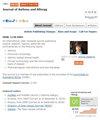在一项横断面观察研究中,吸烟、城市住房和工作引发的哮喘与哮喘严重程度有关
IF 3.7
3区 医学
Q2 ALLERGY
引用次数: 0
摘要
目的:严重哮喘影响到 5%至 10%的哮喘患者,在与哮喘有关的发病率和费用中占很大比例。人们对哮喘严重程度的决定因素知之甚少。我们测试了以下假设:哮喘严重程度与 1) 特异反应和过敏有关;2) 与环境暴露有关:我们分析了 FASE-CPHG 研究(一项横断面、观察性、多中心调查)的数据,以确定与哮喘严重程度相关的标记物。哮喘严重程度用 ASSESS 评分来衡量,包括症状控制、恶化、FEV1 和治疗负荷。双变量和多变量分析用于确定与 ASSESS 评分相关的患者特征:分析涉及 948 名患者,其中女性 592 人,447 名患者(47%)患有严重哮喘。其中,491 名患者(52%)至少有一次过敏原皮肤点刺试验呈阳性,525 名患者(55%)至少有一种过敏性疾病,包括特应性皮炎、慢性鼻炎和食物过敏。ASSESS 评分的平均值为 11.2±3.4。与 ASSESS 得分较高相关的特征有:女性、中等或以下教育程度、失业职业状况、吸烟、工作加重哮喘和城市住房。ASSESS 评分与过敏性疾病、航空过敏原特异性皮肤点刺试验和 IgEs 或血液嗜酸性粒细胞计数之间没有关联:结论:虽然哮喘患者中经常出现特应性和过敏性疾病,但这两种疾病都与哮喘的严重程度无关。吸烟、城市住房和工作导致的哮喘等可改变的环境因素与哮喘严重程度有独立关联。本文章由计算机程序翻译,如有差异,请以英文原文为准。
Smoking, Urban Housing and Work-Aggravated Asthma are Associated with Asthma Severity in a Cross-Sectional Observational Study
Purpose: Severe asthma affects 5 to 10% of asthmatics and accounts for a large part of asthma-related morbidity and costs. The determinants of asthma severity are poorly understood. We tested the hypothesis that asthma severity was associated with 1) atopy and allergy and 2) markers associated with environmental exposure.
Patients and Methods: Data from the FASE-CPHG study, a cross-sectional, observational, multicenter investigation, were analyzed to identify markers associated with asthma severity. Asthma severity was gauged using the ASSESS score, encompassing symptom control, exacerbations, FEV1 and therapeutic load. Bivariate and multivariate analyses were used to identify patient characteristics associated with the ASSESS score.
Results: The analysis involved 948 patients, with 592 women, of which 447 patients (47%) had severe asthma. Among these, 491 patients (52%) had at least one positive aeroallergen skin prick test and 525 (55%) had at least one allergic disease among atopic dermatitis, chronic rhinitis and food allergy. The mean±SD ASSESS score was 11.2± 3.4. Characteristics associated with a higher ASSESS score were female sex, secondary or lower education, unemployed occupational status, smoking, work-aggravated asthma and urban housing. There was no association between the ASSESS score and allergic diseases, aeroallergen-specific skin prick tests and IgEs, or blood eosinophil counts.
Conclusion: While atopy and allergy were frequent among asthmatics, neither was associated with asthma severity. Modifiable environmental factors such as smoking, urban housing and work-aggravated asthma were independently associated with asthma severity.
Keywords: allergy, ASSESS, asthma, environment, severity
Patients and Methods: Data from the FASE-CPHG study, a cross-sectional, observational, multicenter investigation, were analyzed to identify markers associated with asthma severity. Asthma severity was gauged using the ASSESS score, encompassing symptom control, exacerbations, FEV1 and therapeutic load. Bivariate and multivariate analyses were used to identify patient characteristics associated with the ASSESS score.
Results: The analysis involved 948 patients, with 592 women, of which 447 patients (47%) had severe asthma. Among these, 491 patients (52%) had at least one positive aeroallergen skin prick test and 525 (55%) had at least one allergic disease among atopic dermatitis, chronic rhinitis and food allergy. The mean±SD ASSESS score was 11.2± 3.4. Characteristics associated with a higher ASSESS score were female sex, secondary or lower education, unemployed occupational status, smoking, work-aggravated asthma and urban housing. There was no association between the ASSESS score and allergic diseases, aeroallergen-specific skin prick tests and IgEs, or blood eosinophil counts.
Conclusion: While atopy and allergy were frequent among asthmatics, neither was associated with asthma severity. Modifiable environmental factors such as smoking, urban housing and work-aggravated asthma were independently associated with asthma severity.
Keywords: allergy, ASSESS, asthma, environment, severity
求助全文
通过发布文献求助,成功后即可免费获取论文全文。
去求助
来源期刊

Journal of Asthma and Allergy
Medicine-Immunology and Allergy
CiteScore
5.30
自引率
6.20%
发文量
185
审稿时长
16 weeks
期刊介绍:
An international, peer-reviewed journal publishing original research, reports, editorials and commentaries on the following topics: Asthma; Pulmonary physiology; Asthma related clinical health; Clinical immunology and the immunological basis of disease; Pharmacological interventions and new therapies.
Although the main focus of the journal will be to publish research and clinical results in humans, preclinical, animal and in vitro studies will be published where they shed light on disease processes and potential new therapies.
 求助内容:
求助内容: 应助结果提醒方式:
应助结果提醒方式:


